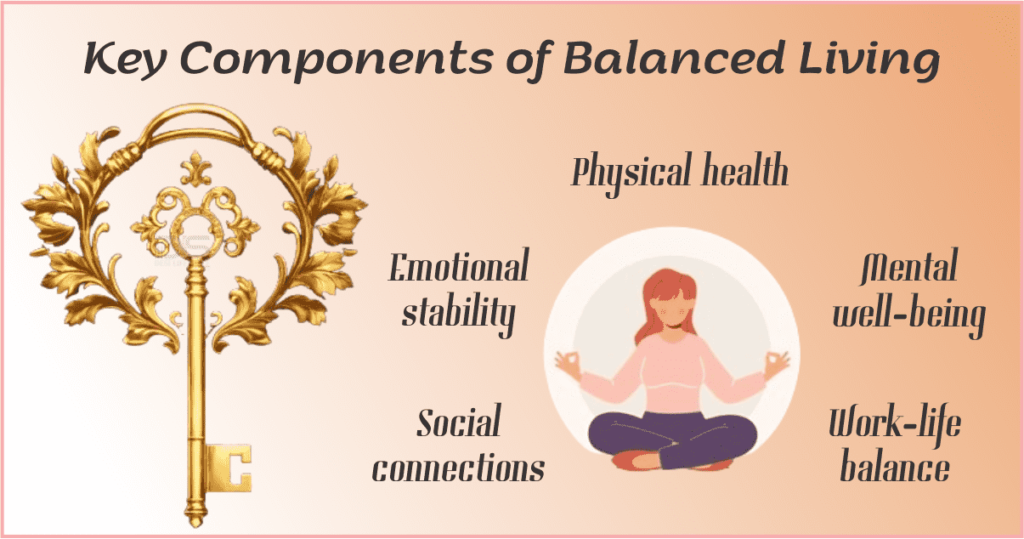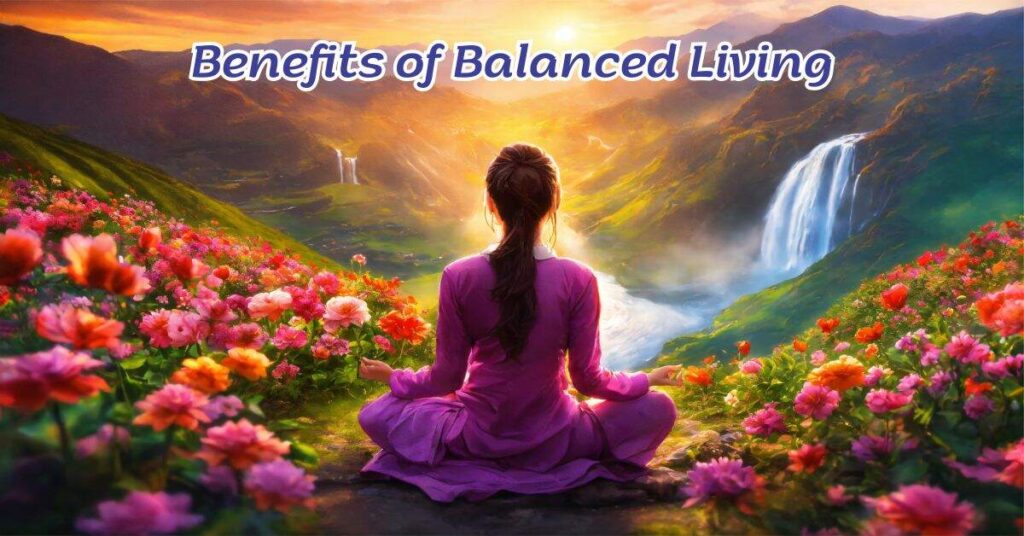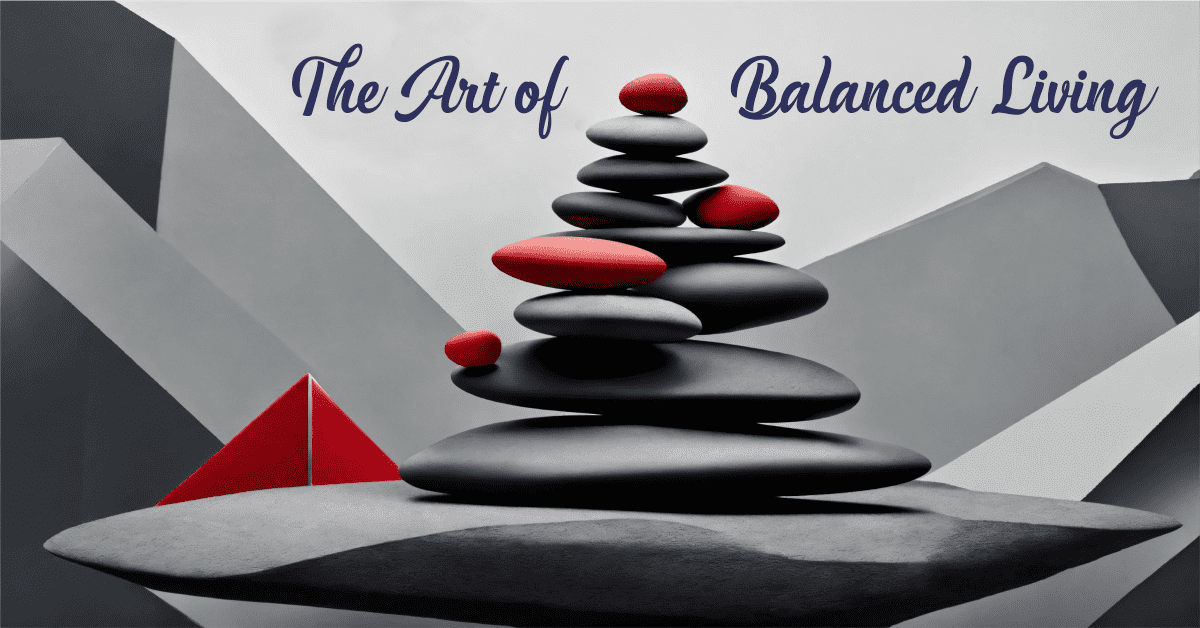Unlock the secrets to a harmonious life with our guide on “The Art of Balanced Living.” Explore practical strategies for physical health, mental well-being, work-life balance, and more to achieve a truly balanced lifestyle.
Introduction
Definition of balanced living:
Balanced living is the art of harmonizing various aspects of life to achieve overall well-being. It involves finding equilibrium between work, relationships, health, and personal fulfillment.
Importance of balance in life:
Balance is crucial for maintaining physical health, mental clarity, and emotional stability. It allows individuals to lead fulfilling lives and pursue their goals with purpose and enthusiasm.
Understanding Balanced Living
Explaining the concept of balance:
Balanced living entails prioritizing different areas of life without neglecting any one aspect. It involves recognizing the interconnectedness of various elements and striving for harmony.
Benefits of achieving balance:
By achieving The Art of Balanced Living, individuals experience reduced stress, improved productivity, and greater satisfaction in both their personal and professional lives.
Key Components of Balanced Living

Physical health:
Physical health encompasses regular exercise, nutritious eating habits, and sufficient rest. Prioritizing physical well-being is essential for energy and vitality.
Mental well-being:
Mental well-being involves managing stress, practicing self-care, and fostering resilience. It includes activities like meditation, journaling, and therapy to support emotional health.
Emotional stability:
Emotional stability is achieved through The Art of Balanced Living, encompassing self-awareness, effective communication, and healthy coping mechanisms. It enables individuals to navigate life’s challenges with grace and resilience.
Work-life balance:
Achieving work-life balance involves setting boundaries, prioritizing tasks, and making time for leisure activities. It allows individuals to excel in their careers while also nurturing personal relationships and hobbies.
Social connections:
Social connections are vital for emotional support and fulfillment. Cultivating meaningful relationships with friends, family, and community members enriches life and enhances overall well-being.
Practical Tips for Balanced Living
Time management:
Effective time management involves prioritizing tasks, setting realistic goals, and eliminating distractions. It helps individuals make the most of their time and reduce feelings of overwhelm.
Stress reduction techniques:
Stress reduction techniques such as deep breathing, mindfulness meditation, and physical activity help individuals manage stress and maintain emotional equilibrium in The Art of Balanced Living.
Mindfulness practices:
Mindfulness practices involve staying present in the moment, observing thoughts and emotions without judgment, and cultivating gratitude. They promote inner peace and contentment.
Benefits of Balanced Living

Improved overall health:
Balanced living contributes to improved physical health, mental clarity, and emotional well-being. It reduces the risk of chronic diseases and enhances longevity.
Enhanced productivity:
By managing stress and maintaining energy levels, balanced living boosts productivity and creativity. Individuals are better able to focus on tasks and achieve their goals.
Better relationships:
Balanced living fosters healthier relationships with oneself and others. It allows individuals to communicate effectively, express empathy, and cultivate deeper connections in The Art of Balanced Living.
Challenges and Obstacles
Identifying common challenges:
Common challenges to The Art of Balanced Living include time constraints, work-related stress, and difficulty prioritizing self-care.
Overcoming obstacles to balance:
Overcoming obstacles requires self-awareness, resilience, and a willingness to seek support from others. It involves setting boundaries, managing time effectively, and practicing self-compassion.
Personal Stories and Examples
Real-life experiences of individuals achieving balanced living:
Stories of individuals who have successfully achieved balanced living serve as inspiration and guidance for others. These stories highlight the importance of perseverance, self-care, and resilience.
Tools and Resources
Apps and tools for maintaining balance:
Numerous apps and tools are available to help individuals maintain balance in their lives. From meditation apps to productivity trackers, these resources provide support and guidance.
Recommended readings and resources:
Books, articles, and podcasts on balanced living offer valuable insights and practical tips for achieving harmony in life. These resources cover topics such as time management, stress reduction, and mindfulness.
Maintaining Balance in Different Life Stages
Balancing priorities in various life stages:
The challenges of balanced living vary depending on life stage, from early adulthood to retirement. In The Art of Balanced Living, each stage presents unique opportunities for growth and self-discovery.
Cultivating Mindfulness and Self-Awareness
Practices for increasing self-awareness:
Increasing self-awareness involves reflection, journaling, and seeking feedback from others. It allows individuals to identify their values, strengths, and areas for growth.
Incorporating mindfulness into daily routines:
Mindfulness can be incorporated into daily routines through practices such as mindful eating, mindful walking, and mindfulness meditation. These practices promote presence and awareness in everyday life.
Building Support Systems
Importance of a strong support network:
A strong support network provides encouragement, guidance, and emotional support during challenging times. Cultivating meaningful connections with friends, family, and mentors is essential for balanced living.
Seeking Help When Needed in The Art of Balanced Living:
Seeking help from professionals, such as therapists or life coaches, is a sign of strength, not weakness. In The Art of Balanced Living, it’s important to reach out for support when facing challenges or struggling to maintain balance.
Overcoming Guilt and Perfectionism
Strategies for letting go of perfectionism:
Letting go of perfectionism involves setting realistic expectations, embracing imperfection, and celebrating progress over perfection. It’s about valuing effort and growth rather than flawless outcomes.
Dealing with guilt and self-criticism:
Dealing with guilt and self-criticism requires self-compassion and forgiveness. It involves challenging negative self-talk, practicing self-care, and acknowledging one’s worthiness.
Staying Flexible and Adaptable
Embracing change and uncertainty:
Embracing change and uncertainty is essential for balanced living. It involves being open to new experiences, learning from setbacks, and adapting to evolving circumstances.
Adjusting plans and goals as needed:
Flexibility involves adjusting plans and goals as needed based on changing priorities and circumstances. It’s about staying nimble and responsive to life’s twists and turns.
Celebrating Progress and Successes
Recognizing achievements along the journey:
Celebrating progress and successes, no matter how small, is essential for maintaining motivation and momentum. It involves acknowledging achievements, expressing gratitude, and reflecting on growth.
Practicing gratitude and self-compassion:
Practicing gratitude and self-compassion fosters a positive mindset and resilience. It involves acknowledging one’s blessings, expressing appreciation for oneself and others, and cultivating kindness toward oneself.
Conclusion
In conclusion, the art of balanced living is a journey of self-discovery, growth, and fulfillment. By embracing mindfulness, prioritizing self-care, and nurturing meaningful connections, individuals can achieve harmony in all aspects of their lives. Remember, balance is not a destination but a continuous process of adjustment and alignment. So, embark on your journey to balanced living with courage and curiosity, and may you find joy and fulfillment along the way.
FAQs
How can I start incorporating balance into my life today?
- Begin by identifying areas of imbalance and setting small, achievable goals to address them.
- Experiment with different self-care practices and find what resonates with you personally.
- Keep in mind that balance is a voyage and it’s alright to make some corrections on the way.
What are some signs that my life may be out of balance?
- Feeling constantly overwhelmed or stressed.
- Neglecting self-care and personal hobbies.
- Struggling to maintain healthy relationships or experiencing frequent conflicts.
Is achieving balance a one-time effort, or does it require ongoing maintenance?
- Living a balanced life is a process that lasts forever and which requires regular monitoring, modifications.
- Prioritize self-reflection and check-ins to ensure that you’re staying aligned with your values and goals.
How can I overcome obstacles to achieving balance, such as work-related stress or financial strain?
- When things are tough, you should turn to your friends, family, or a professional counsellor.
To prevent feeling too much pressure, break your tasks down into smaller and more controllable parts. - Remember to prioritize self-care and seek out activities that bring you joy and relaxation.
What are some common misconceptions about balanced living?
- That balance means achieving perfection in every aspect of life.
- That balance is a static state rather than a dynamic process of continual adjustment.
- That achieving balance requires sacrificing one’s ambitions or goals.

